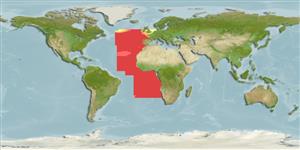>
Scombriformes (Mackerels) >
Caristiidae (Manefishes)
Etymology: Platyberyx: Name from the Greek 'platy' meaning flat and Beryx, a genus of beryciform fishes.; opalescens: Name from Latin 'opalus', for an opal..
Environment: milieu / climate zone / depth range / distribution range
Ekologi
marina batypelagisk; djupintervall 1 - 2000 m (Ref. 94277). Subtropical; 55°N - 27°S (Ref. 94277)
Eastern Atlantic.
Size / Vikt / Age
Maturity: Lm ? range ? - ? cm
Max length : 13.9 cm SL hane/ej könsbestämd; (Ref. 126117); publicerad maxvikt: 123.00 g (Ref. 126117)
Short description
Bestämningsnycklar | Morfologi | Morfometri
Mjukstrålar i ryggfenan (totalt) : 27 - 29; Mjukstrålar i analfenan: 17 - 19; Ryggkotor: 32 - 34. This species is distinguished by the following characters: differs from P. paucus by having greater number of dorsal-fin rays (27-29 vs. 24-25), anal-fin rays (17-19 vs. 15-16), pectoral-fin rays (17-20 vs. 16-17), and vertebrae (32-34 vs. 31); from P. andriashevi by having fewer dorsal-fin rays (27-29 vs. 31-37), anal-fin rays (17-19 vs. 19-22), and vertebrae (32-34 vs. 36-39); and from both species by caudal-fin morphology (ventral caudal spur absent, procurrent rays cylindrical vs. ventral caudal spur present, procurrent rays flattened, bladelike); differs from P. rhyton and P. mauli by morphometrics, including a deeper body (52-64% vs. 45-52% SL), longer head length (>38% vs. <34% SL), longer prepectoral length (>39% vs. <36% SL), and smaller mouth (upper jaw extending approximately to mid-orbit vs. posterior margin of orbit); differs from P. pietschi by caudal-fin morphology (ventral caudal spur absent, procurrent rays cylindrical vs. ventral caudal spur present, procurrent rays flattened, bladelike) and gill-raker morphology (bristles on gill rakers small and uniform vs. small bristles and large spikes on rakers) (Ref. 94277).
Max. length of a photo (Rógvi Mouritsen, pers. comm., 2003).
Life cycle and mating behavior
Maturities | Reproduktion | Spawnings | Egg(s) | Fecundities | Larver
Stevenson, D.E. and C.P. Kenaley, 2013. Revision of the manefish genera Caristius and Platyberyx (Teleostei: Percomorpha: Caristiidae), with description of five new species. Copeia 2013(3):415-434. (Ref. 94277)
IUCN Red List Status (Ref. 130435)
Threat to humans
Harmless
Human uses
Verktyg
Special reports
Download XML
Internet-källor
Estimates based on models
Preferred temperature (Ref.
123201): 6.3 - 11.6, mean 10.4 °C (based on 91 cells).
Phylogenetic diversity index (Ref.
82804): PD
50 = 0.5156 [Uniqueness, from 0.5 = low to 2.0 = high].
Bayesian length-weight: a=0.01995 (0.00906 - 0.04395), b=3.01 (2.83 - 3.19), in cm total length, based on all LWR estimates for this body shape (Ref.
93245).
Trofisk nivå (Ref.
69278): 3.5 ±0.5 se; based on size and trophs of closest relatives
Fishing Vulnerability (Ref.
59153): Low vulnerability (10 of 100).
